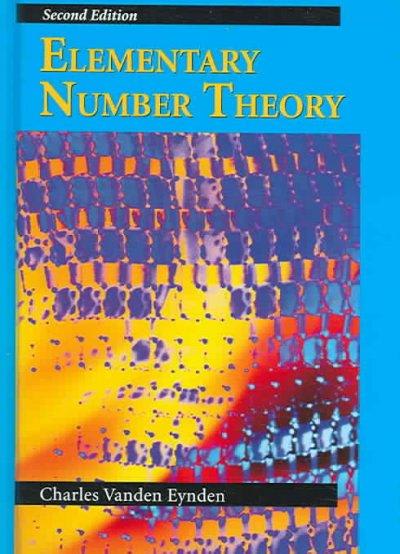
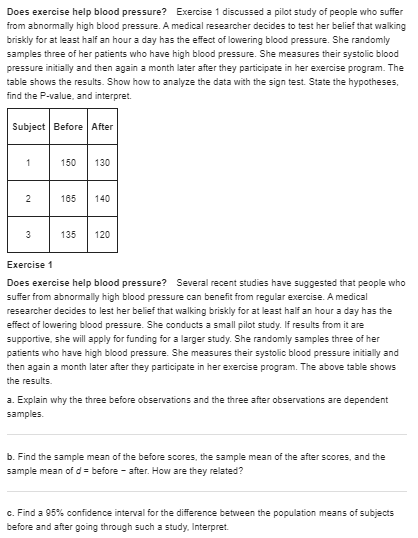
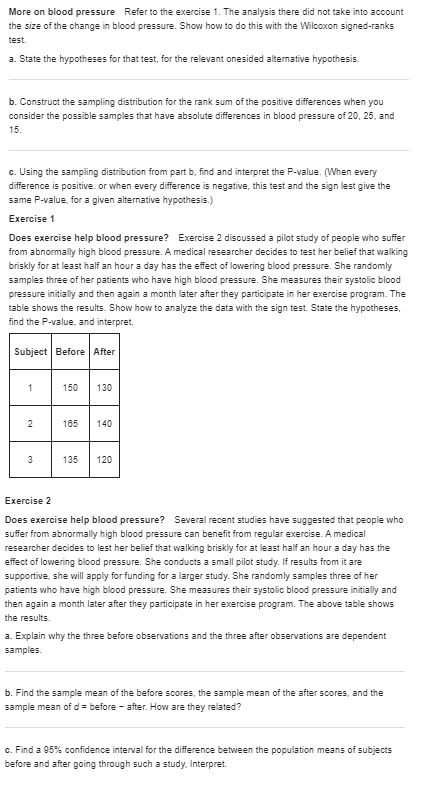
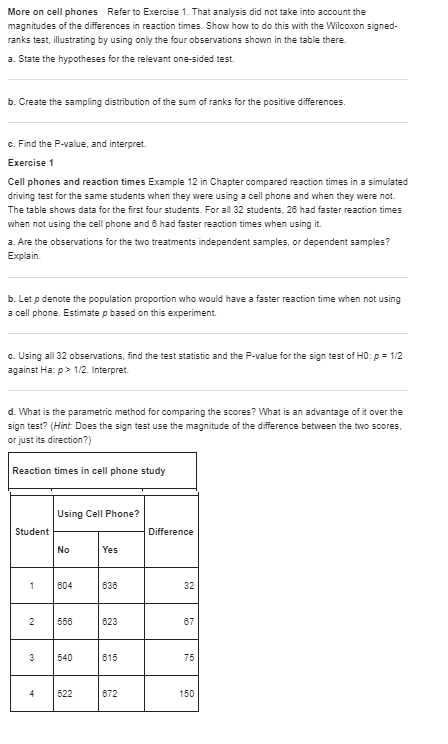
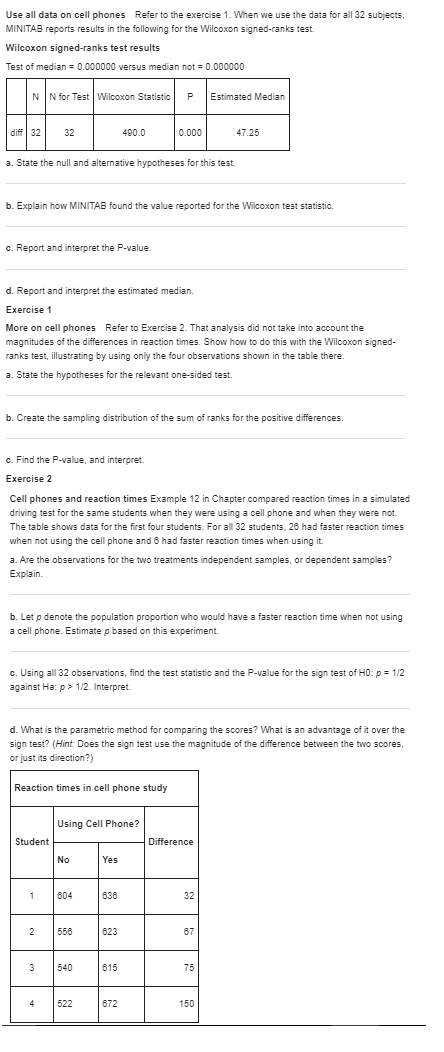
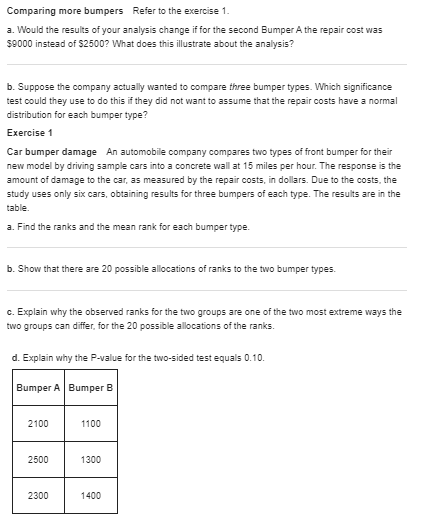
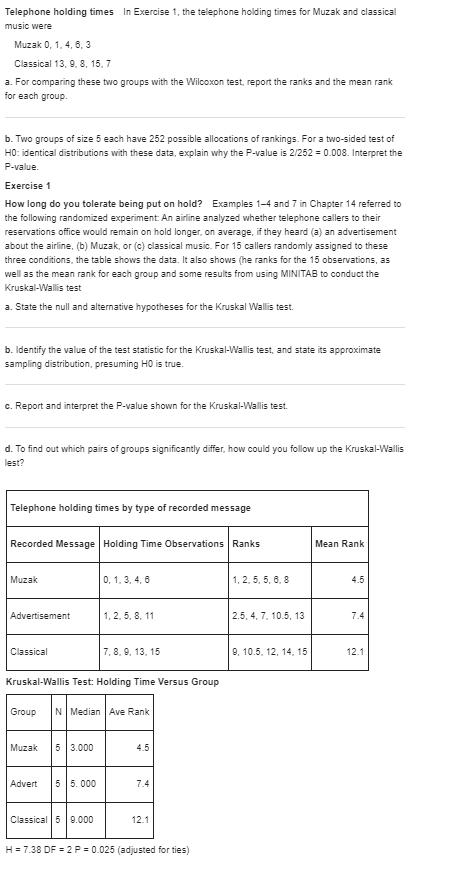

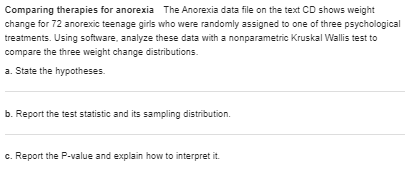
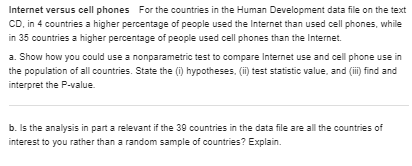
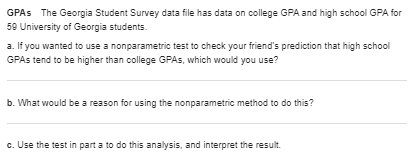
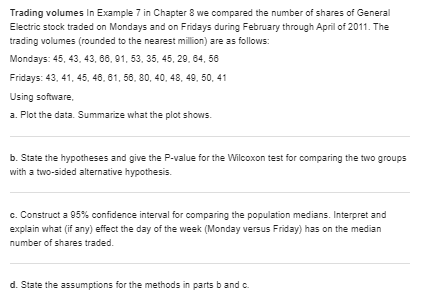

explain in details;-
More on blood pressure Refer to the exercise 1. The analysis there did not take into account the size of the change in blood pressure. Show how to do this with the Wilcoxon signed-ranks test. a. State the hypotheses for that test, for the relevant onesided alternative hypothesis. b. Construct the sampling distribution for the rank sum of the positive differences when you consider the possible samples that have absolute differences in blood pressure of 20, 25, and 15. c. Using the sampling distribution from part b, find and interpret the P-value. (When every difference is positive. or when every difference is negative, this test and the sign lest give the same P-value, for a given alternative hypothesis.} Exercise 1 Does exercise help blood pressure? Exercise 2 discussed a pilot study of people who suffer from abnormally high blood pressure. A medical researcher decides to test her belief that walking briskly for at least half an hour a day has the effect of lowering blood pressure. She randomly samples three of her patients who have high blood pressure. She measures their systolic blood pressure initially and then again a month later after they participate in her exercise program. The table shows the results. Show how to analyze the data with the sign test. State the hypotheses, find the P-value, and interpret. Subject Before | After 150 130 2 185 140 3 135 120 Exercise 2 Does exercise help blood pressure? Several recent studies have suggested that people who suffer from abnormally high blood pressure can benefit from regular exercise. A medical researcher decides to lest her belief that walking briskly for at least half an hour a day has the effect of lowering blood pressure. She conducts a small pilot study. If results from it are supportive. she will apply for funding for a larger study. She randomly samples three of her patients who have high blood pressure. She measures their systolic blood pressure initially and then again a month later after they participate in her exercise program. The above table shows the results. a. Explain why the three before observations and the three after observations are dependent samples. b. Find the sample mean of the before scores, the sample mean of the after scores, and the sample mean of d = before - after. How are they related? c. Find a 95%% confidence interval for the difference between the population means of subjects before and after going through such a study. Interpret.More on cell phones Refer to Exercise 1. That analysis did not take into account the magnitudes of the differences in reaction times. Show how to do this with the Wilcoxon signed- ranks test, illustrating by using only the four observations shown in the table there. a. State the hypotheses for the relevant one-sided test. b. Create the sampling distribution of the sum of ranks for the positive differences. c. Find the P-value, and interpret. Exercise 1 Cell phones and reaction times Example 12 in Chapter compared reaction times in a simulated driving test for the same students when they were using a cell phone and when they were not. The table shows data for the first four students. For all 32 students, 26 had faster reaction times when not using the cell phone and 8 had faster reaction times when using it. a. Are the observations for the two treatments independent samples, or dependent samples? Explain. b. Let p denote the population proportion who would have a faster reaction time when not using a cell phone. Estimate p based on this experiment. c. Using all 32 observations, find the test statistic and the P-value for the sign test of HO: p = 1/2 against Ha: p > 1/2. Interpret. d. What is the parametric method for comparing the scores? What is an advantage of it over the sign test? (Hint: Does the sign test use the magnitude of the difference between the two scores, or just its direction?) Reaction times in cell phone study Using Cell Phone? Student Difference No Yes 1 604 636 3.2 2 556 823 87 3 540 615 75 4 522 672 150Use all data on cell phones Refer to the exercise 1. When we use the data for all 32 subjects, MINITAB reports results in the following for the Wilcoxon signed-ranks test. Wilcoxon signed-ranks test results Test of median = 0.000000 versus median not = 0.000000 I N for Test | Wilcoxon Statistic P Estimated Median diff | 32 32 490.0 0.000 47.25 a. State the null and alternative hypotheses for this test. b. Explain how MINITAB found the value reported for the Wilcoxon test statistic. c. Report and interpret the P-value. d. Report and interpret the estimated median. Exercise 1 More on cell phones Refer to Exercise 2. That analysis did not take into account the magnitudes of the differences in reaction times. Show how to do this with the Wilcoxon signed- ranks test, illustrating by using only the four observations shown in the table there. a. State the hypotheses for the relevant one-sided test. b. Create the sampling distribution of the sum of ranks for the positive differences. C. Find the P-value, and interpret. Exercise 2 Cell phones and reaction times Example 12 in Chapter compared reaction times in a simulated driving test for the same students when they were using a cell phone and when they were not The table shows data for the first four students. For all 32 students, 28 had faster reaction times when not using the cell phone and 8 had faster reaction times when using it. a. Are the observations for the two treatments independent samples, or dependent samples? Explain. b. Let p denote the population proportion who would have a faster reaction time when not using a cell phone. Estimate p based on this experiment. c. Using all 32 observations, find the test statistic and the P-value for the sign test of HO: p = 1/2 against Ha: p > 1/2. Interpret. d. What is the parametric method for comparing the scores? What is an advantage of it over the sign test? (Hint: Does the sign test use the magnitude of the difference between the two scores, or just its direction?) Reaction times in cell phone study Using Cell Phone? Student Difference No Yes 1 604 636 32 2 556 623 67 3 540 615 75 522 672 150Comparing more bumpers Refer to the exercise 1. a. Would the results of your analysis change if for the second Bumper A the repair cost was $9000 instead of $2500? What does this illustrate about the analysis? b. Suppose the company actually wanted to compare three bumper types. Which significance test could they use to do this if they did not want to assume that the repair costs have a normal distribution for each bumper type? Exercise 1 Car bumper damage An automobile company compares two types of front bumper for their new model by driving sample cars into a concrete wall at 15 miles per hour. The response is the amount of damage to the car, as measured by the repair costs, in dollars. Due to the costs, the study uses only six cars, obtaining results for three bumpers of each type. The results are in the table a. Find the ranks and the mean rank for each bumper type. b. Show that there are 20 possible allocations of ranks to the two bumper types. c. Explain why the observed ranks for the two groups are one of the two most extreme ways the two groups can differ, for the 20 possible allocations of the ranks. d. Explain why the P-value for the two-sided test equals 0.10. Bumper A | Bumper B 2100 1100 2500 1300 2300 1400Telephone holding times In Exercise 1, the telephone holding times for Muzak and classical music were Muzak 0, 1. 4, 6, 3 Classical 13, 9. 8, 15. 7 a. For comparing these two groups with the Wilcoxon test, report the ranks and the mean rank for each group. b. Two groups of size 5 each have 252 possible allocations of rankings. For a two-sided test of HO: identical distributions with these data, explain why the P-value is 2/252 = 0.008. Interpret the P-value. Exercise 1 How long do you tolerate being put on hold? Examples 1-4 and 7 in Chapter 14 referred to the following randomized experiment: An airline analyzed whether telephone callers to their reservations office would remain on hold longer, on average, if they heard (3) an advertisement about the airline, (b) Muzak, or (c) classical music. For 15 callers randomly assigned to these three conditions, the table shows the data. It also shows the ranks for the 15 observations, as well as the mean rank for each group and some results from using MINITAB to conduct the Kruskal-Wallis test a. State the null and alternative hypotheses for the Kruskal Wallis test. b. Identify the value of the test statistic for the Kruskal-Wallis test, and state its approximate sampling distribution, presuming HO is true. c. Report and interpret the P-value shown for the Kruskal-Wallis test. d. To find out which pairs of groups significantly differ, how could you follow up the Kruskal-Wallis lest? Telephone holding times by type of recorded message Recorded Message | Holding Time Observations | Ranks Mean Rank Muzak 0, 1. 3, 4, 6 1, 2, 5, 5, 6, 8 4.5 Advertisement 1, 2, 5, 8, 11 2.5, 4, 7, 10.5, 13 7.4 Classical 7, 8. 9, 13, 15 9, 10.5. 12, 14, 15 12.1 Kruskal-Wallis Test: Holding Time Versus Group Group N Median |Ave Rank Muzak 5 3.000 4.5 Advert 5 5. 000 7.4 Classical | 5 9.000 12.1 H = 7.38 DF = 2 P = 0.025 (adjusted for ties)\fWhat's the best way to learn French? Exercise 1 gave the data in the table for scores on the first quiz for ninthgrade students in an introductory-level French course. The instructor grouped the students in the course as follows: Group 1 : Never studied foreign language before, but have good English skills Group 2: Never studied foreign language before; have poor English skills Group 3: Studied at least one other foreign language The table also shows results of using MINITAB to perform the Kruskal-Wallis test. a. Find the rank associated with each observation, and show how to find the mean rank for Group 1. b. Report and interpret the P-value for the test. Scores on the quiz Group 1 Group 2| Group 3 g 51 10 8 5 Kruskal-Wallis Test on response Group N Median | Ave Rank 8. 000 4.3 2 2 3.000 2.3 3 9.000 8.2 9.000 8.2 H = 3.13 DF = 2 P = 0.209 (adjusted for ties) Exercise 1 What's the best way to learn French? The following table shows scores on the first quiz (maximum score 10 points) for eighth-grade students in an introductory level French course. The instructor grouped the students in the course as follows: Group 1: Never studied foreign language before but have good English skills Group 2: Never studied foreign language before and have poor English skills Group 3: Studied at least one other foreign language French scores on the quiz Group 1 Group 2 Group 3 9 5 5 Mear 60 3.0 8.0 Std. Dev. |2.000 2.828 2.646 Source DE SS MS C Group 3 0.00 15.00 2.50 0.177 Error 5 0.00 |6.00 Total 10.00 Defining notation and using results obtained with software, also shown in the table, report the Ive steps of the ANOVA test. . The sample means are quite different, but the P-value is not small. Name one important eason for this. (Hint: For given sample means, how do the results of the test depend on the sample sizes?) Was this an experimental study. or an observational study? Explain how a lurking variable ould be responsible for Group 3 having a larger mean than the others. (Thus, even if the P- value were small, it is inappropriate to assume that having studied at least one foreign language causes one to perform better on this quiz.)
































